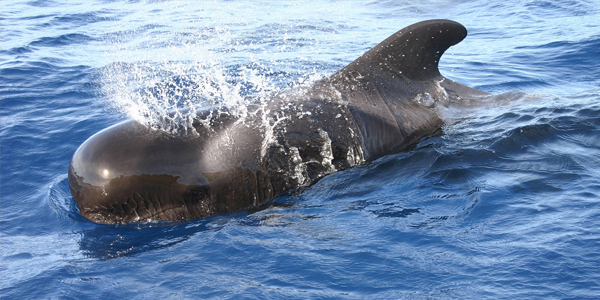Articles
African Animals Fun Facts
Giraffe Have Blue Tongues.
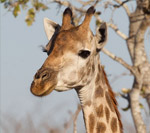 Giraffe are rather bizarre looking animals anyway, let alone the fact that their tongues are dark blue and average around 20 inches in length. The length of their tongues allows them to browse for very highest, juiciest leaves on their favorite acacia trees. Giraffes also have little 5 inch knobs on their heads and (obviously) outrageously long necks. The giraffe neck contains special veins and blood valves to stop the giraffe from blacking out when it takes a drink. They can't drink for long because of this and they don't drink often, they can survive without water for weeks at a time. Baby giraffes drop six feet to the ground when born but manage to stand up just five minutes later. If you're out camping in the African bush you'll never be startled by a loud growling or grunting from a giraffe, they are very quiet indeed.
Giraffe are rather bizarre looking animals anyway, let alone the fact that their tongues are dark blue and average around 20 inches in length. The length of their tongues allows them to browse for very highest, juiciest leaves on their favorite acacia trees. Giraffes also have little 5 inch knobs on their heads and (obviously) outrageously long necks. The giraffe neck contains special veins and blood valves to stop the giraffe from blacking out when it takes a drink. They can't drink for long because of this and they don't drink often, they can survive without water for weeks at a time. Baby giraffes drop six feet to the ground when born but manage to stand up just five minutes later. If you're out camping in the African bush you'll never be startled by a loud growling or grunting from a giraffe, they are very quiet indeed.
Ostriches Can Sprint over 40 miles an Hour.
 Ostriches can sprint up to 43 miles (70 kilometers) an hour and use their wings as rudders to change direction. The can kick a man to death, but only in a forward direction, so it's safer to stay around the back. Ostriches are the largest birds on earth. Ostriches are farmed for their eggs among other things. One egg can easily make an omelet for a dozen hungry men. Their shells have been used to make ornaments and necklaces for thousands of years by several African tribes. The shells are also handy for storing water. Ostrich meat is a popular lean red meat in upscale restaurants throughout the world. Their feathers are also widely used in costume design. On some ostrich farms, races are a regular event, and you can try and ride an ostrich in Oudtshoorn, in South Africa's Karoo desert
Ostriches can sprint up to 43 miles (70 kilometers) an hour and use their wings as rudders to change direction. The can kick a man to death, but only in a forward direction, so it's safer to stay around the back. Ostriches are the largest birds on earth. Ostriches are farmed for their eggs among other things. One egg can easily make an omelet for a dozen hungry men. Their shells have been used to make ornaments and necklaces for thousands of years by several African tribes. The shells are also handy for storing water. Ostrich meat is a popular lean red meat in upscale restaurants throughout the world. Their feathers are also widely used in costume design. On some ostrich farms, races are a regular event, and you can try and ride an ostrich in Oudtshoorn, in South Africa's Karoo desert
The Vegetarian Hippo is one of Africa's Most Deadly Animals.
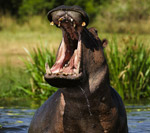 Male hippos actively defend their territories and humans tend to get killed by hippos when they stand on a riverbank or beach that a male hippo considers to be his territory. Females have also been known to get extremely aggressive if they sense anyone coming in between their babies, who stay in the water while they feed on the shore. Hippos can run at speeds of over 20 miles an hour and they have enormous jaws host up to 20 inch canines. Hippos are vegetarian and consume up to a hundred pounds of the green stuff every day. This feeding schedule means hippos also poop huge amounts, up to sixty pounds a day, and some of it is literally showered around by a fast moving, rotating tail. Hippos are sensitive to the sun and secrete a natural sunscreen that is colored red and eventually turns brown. The hippo's closest living relative is the whale. And while hippos can swim and stay underwater for up to ten minutes at a time, they cannot jump.
Male hippos actively defend their territories and humans tend to get killed by hippos when they stand on a riverbank or beach that a male hippo considers to be his territory. Females have also been known to get extremely aggressive if they sense anyone coming in between their babies, who stay in the water while they feed on the shore. Hippos can run at speeds of over 20 miles an hour and they have enormous jaws host up to 20 inch canines. Hippos are vegetarian and consume up to a hundred pounds of the green stuff every day. This feeding schedule means hippos also poop huge amounts, up to sixty pounds a day, and some of it is literally showered around by a fast moving, rotating tail. Hippos are sensitive to the sun and secrete a natural sunscreen that is colored red and eventually turns brown. The hippo's closest living relative is the whale. And while hippos can swim and stay underwater for up to ten minutes at a time, they cannot jump.
Hyenas are More Closely Related to Cats than Dogs.
 Hyenas are more closely related to cats than dogs, and even more closely related to meerkats. Hyenas are the most common of all large carnivores in Africa, they are true survivalists. They live in clans, with some groups numbering over 70 members. Hyena cubs are most commonly born in twos and if they are the same sex, they may try and kill each other. They are known as scavengers, but also regularly hunt live prey. Hyena dung is white (when dry) because of the large amounts of calcium it consumes when crunching up the bones of its kill. A team of researchers excavating a cave near Johannesburg, South Africa, discovered five human hairs at least 200,000 years old in fossilized hyena dung, thus exceeding the record for the oldest known human hair by more than 190,000 years. There is quite a difference between young spotted hyenas and young striped hyenas. Striped hyenas are born with adult markings, closed eyes and small ears. Spotted hyenas are born with eyes wide open and teeth intact, ready for action. They live in clans dominated by the larger built females.
Hyenas are more closely related to cats than dogs, and even more closely related to meerkats. Hyenas are the most common of all large carnivores in Africa, they are true survivalists. They live in clans, with some groups numbering over 70 members. Hyena cubs are most commonly born in twos and if they are the same sex, they may try and kill each other. They are known as scavengers, but also regularly hunt live prey. Hyena dung is white (when dry) because of the large amounts of calcium it consumes when crunching up the bones of its kill. A team of researchers excavating a cave near Johannesburg, South Africa, discovered five human hairs at least 200,000 years old in fossilized hyena dung, thus exceeding the record for the oldest known human hair by more than 190,000 years. There is quite a difference between young spotted hyenas and young striped hyenas. Striped hyenas are born with adult markings, closed eyes and small ears. Spotted hyenas are born with eyes wide open and teeth intact, ready for action. They live in clans dominated by the larger built females.
Lions Sleep for 20 Hours a Day.
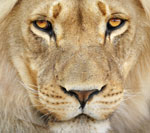 The African lion (Panthera leo) king of the sub-Saharan savanna, has been admired by man for its beauty and strength for thousands of years. It's one of the most exciting animals to see on safari. But you're more likely to see one sleeping than hunting because lions rest for 20 hours a day on average. Lions don't purr like house cats, and the cute tufts on the ends of their tail emerge at around 5 months of age. Lions often kill their prey by strangulation or suffocation (by covering the nostrils and mouth of their prey). Other than man, crocodiles are one of the few natural predators a lion has (although their cubs are vulnerable to other hunters). Lions are the only members of the cat family where the male and female look very different and they are also much more social than most other cats. Lions hate swimming...
The African lion (Panthera leo) king of the sub-Saharan savanna, has been admired by man for its beauty and strength for thousands of years. It's one of the most exciting animals to see on safari. But you're more likely to see one sleeping than hunting because lions rest for 20 hours a day on average. Lions don't purr like house cats, and the cute tufts on the ends of their tail emerge at around 5 months of age. Lions often kill their prey by strangulation or suffocation (by covering the nostrils and mouth of their prey). Other than man, crocodiles are one of the few natural predators a lion has (although their cubs are vulnerable to other hunters). Lions are the only members of the cat family where the male and female look very different and they are also much more social than most other cats. Lions hate swimming...
An Elephant Calf Often Sucks Its Trunk for Comfort.
 Elephants are gentle giants and can grow to be over 14 feet tall and 30 feet wide. They drink 30-50 gallons of water every day and are vegetarians, consuming up to 375 lbs of vegetation every day which can take them up to 16 hours to consume!
Elephants are gentle giants and can grow to be over 14 feet tall and 30 feet wide. They drink 30-50 gallons of water every day and are vegetarians, consuming up to 375 lbs of vegetation every day which can take them up to 16 hours to consume!
Elephants are very social animals, they communicate using a variety of low frequency grumbles and rumbles which can be picked up 6 miles away. They live in family groups of up to 100 members, headed by a matriarch. Elephants are social and affectionate animals. Elephant mothers are very attentive to their babies, orphans are nursed by other mothers in the group. A young elephant is weaned at 4-5 years old, when their tusks start to get in the way, and they may move out of the family group at 10-12 years old. Elephants prefer one tusk over the other, just as people are either left or right-handed. Elephants waive their trunks up in the air and from side to side to smell better.
Black Mamba Venom Can Kill a Dozen Men Within an Hour.
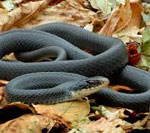 Black Mamba (Dendroaspis polylepis) is one of Africa's most dangerous snakes and feared in East, Central and Southern Africa. It's aggressive when cornered and will not hesitate to strike. It can reach speeds of up to 12 mph (20 km/ph). It's the largest venomous snake in Africa with adults reaching an average of 8 feet in length (2.5m). Black Mamba's are not black at all, but brown/olive skinned. Their mouths are inky black which they show when threatened. Black Mambas live in savanna, scrub, tree hollows, and sometimes people's homes. If a Black Mamba encounters prey it can strike up to 12 times, each time delivering enough neuro and cardio-toxic venom to kill a dozen men within 1 hour. Without anti-venom, the mortality rate is 100%.
Black Mamba (Dendroaspis polylepis) is one of Africa's most dangerous snakes and feared in East, Central and Southern Africa. It's aggressive when cornered and will not hesitate to strike. It can reach speeds of up to 12 mph (20 km/ph). It's the largest venomous snake in Africa with adults reaching an average of 8 feet in length (2.5m). Black Mamba's are not black at all, but brown/olive skinned. Their mouths are inky black which they show when threatened. Black Mambas live in savanna, scrub, tree hollows, and sometimes people's homes. If a Black Mamba encounters prey it can strike up to 12 times, each time delivering enough neuro and cardio-toxic venom to kill a dozen men within 1 hour. Without anti-venom, the mortality rate is 100%.
Crocodiles Have Been Around for Over 200 Million Years
 Crocodiles have been around for 200 million years, outwitting dinosaurs by 60 million years, no wonder they look so prehistoric. While they have a reputation for being aggressive and dangerous, it's usually only the large crocs that will dare attack a man, although the little ones will not think twice about biting off your finger if you close! Crocodiles are very well adapted creatures, they can hold their breath under water for over 10 minutes, and can go for months at a time without food. Crocodiles can also sustain injuries remarkably well, they have a fantastic immune system. Crocodiles have the strongest bite of any animal on earth, but the muscles they use to open their jaws are not so strong, so it is relatively easy to hold their mouth shut (although not recommended). Crocodiles keep their mouths open to stay cool
Crocodiles have been around for 200 million years, outwitting dinosaurs by 60 million years, no wonder they look so prehistoric. While they have a reputation for being aggressive and dangerous, it's usually only the large crocs that will dare attack a man, although the little ones will not think twice about biting off your finger if you close! Crocodiles are very well adapted creatures, they can hold their breath under water for over 10 minutes, and can go for months at a time without food. Crocodiles can also sustain injuries remarkably well, they have a fantastic immune system. Crocodiles have the strongest bite of any animal on earth, but the muscles they use to open their jaws are not so strong, so it is relatively easy to hold their mouth shut (although not recommended). Crocodiles keep their mouths open to stay cool
Credit: goafrica.about.com




